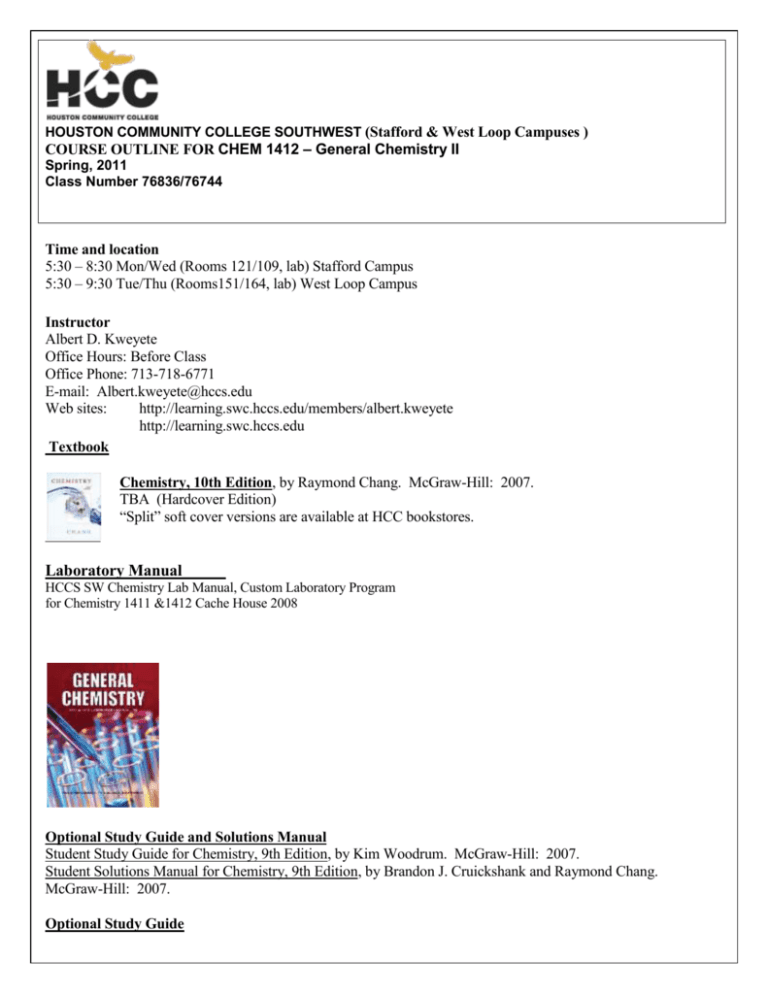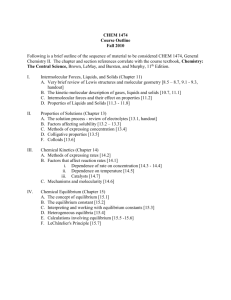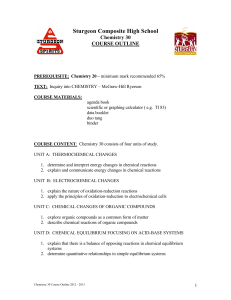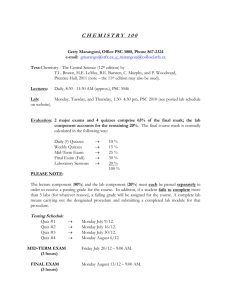Last Day for Administrative and Student Withdrawals
advertisement

HOUSTON COMMUNITY COLLEGE SOUTHWEST (Stafford & West Loop Campuses ) COURSE OUTLINE FOR CHEM 1412 – General Chemistry II Spring, 2011 Class Number 76836/76744 Time and location 5:30 – 8:30 Mon/Wed (Rooms 121/109, lab) Stafford Campus 5:30 – 9:30 Tue/Thu (Rooms151/164, lab) West Loop Campus Instructor Albert D. Kweyete Office Hours: Before Class Office Phone: 713-718-6771 E-mail: Albert.kweyete@hccs.edu Web sites: http://learning.swc.hccs.edu/members/albert.kweyete http://learning.swc.hccs.edu Textbook Chemistry, 10th Edition, by Raymond Chang. McGraw-Hill: 2007. TBA (Hardcover Edition) “Split” soft cover versions are available at HCC bookstores. Laboratory Manual HCCS SW Chemistry Lab Manual, Custom Laboratory Program for Chemistry 1411 &1412 Cache House 2008 Optional Study Guide and Solutions Manual Student Study Guide for Chemistry, 9th Edition, by Kim Woodrum. McGraw-Hill: 2007. Student Solutions Manual for Chemistry, 9th Edition, by Brandon J. Cruickshank and Raymond Chang. McGraw-Hill: 2007. Optional Study Guide Student Solutions Manual to accompany Chemistry, Ninth Edition, prepared by Brandon Cruickshank. McGraw Hill. Course Catalog Description Continuation of CHEM 1411. Topics include solutions, chemical kinetics, equilibrium and equilibrium phenomena in aqueous solution, acids and bases, pH, thermodynamics, electrochemistry, nuclear chemistry, and introduction to organic chemistry, and biochemistry. The laboratory includes appropriate experiments. Prerequisites: CHEM 1411 Credit: 4 (3 lecture, 3 lab) Course Prerequisites These are stated in the course description in the HCC catalog (quoted just above) and they are stressed again here for emphasis. Lack of satisfactory completion of the course prerequisites are one of the main reasons that cause students to do poorly in chemistry. Basic math and problem solving skills at the level of college algebra are essential. If you are not sure if your prior coursework meets these prerequisites, come and talk to me or to the department chair for advice. With the prerequisites satisfactorily completed (preferably with a grade of B or better), you can be confident that you are well-prepared for this course. Course Intent This course is intended for students majoring in one of the physical sciences or life sciences, or for students who are pursuing pre-professional programs in medicine, dentistry, pharmacy, veterinary medicine, or other health programs. The course is also beneficial to students who are preparing themselves for higher level science courses in their respective curricula. Course Content See the course schedule below for the topics (listed by chapter title) that will be covered in this class. College level general chemistry is very similar to a good high school course, but will usually cover the topics in greater detail and will place a greater emphasis on problem solving. Attendance Policy The HCCS attendance policy is stated in the College Catalog or Handbook: “Students are expected to attend classes regularly. Students are responsible for materials covered during their absences, and it is the student's responsibility to consult with instructors for make-up assignments. Class attendance is checked daily by instructors. Although it is the responsibility of the student to drop a course for non-attendance, the instructor has full authority to drop a student for excessive absences. A student may be dropped from a course for excessive absences after the student has accumulated absences in excess of 12.5% of the hours of instruction (including lecture and laboratory time).” Note that 12.5% is approximately 2 classes or labs for a 4-semester hour course, such as this one, which meets 4 times per week in a 5-week semester. If circumstances significantly prevent you from attending classes, please inform me. I realize that sometimes outside circumstances can interfere with school, and I will try to be as accommodating as possible, but please be aware of the attendance policy. Student Learning Outcomes The student will be able to: 1. Distinguish between the different ways of measuring concentrations of solutions, and relate concentration to the colligative properties of solutions. 2. Determine and analyze the rates of chemical reactions. 3. Write equilibrium constant expressions for chemical reactions and calculate the value of the equilibrium constant and the concentration of reactants and products at equilibrium. 4. Demonstrate proficiency in acid-base and solubility product calculations. 5. Express the three laws of thermodynamics and interrelate the enthalpy, free energy and equilibrium constant for the reaction. 6. Based on the principles of oxidation and reduction, balance oxidation-reduction reactions, calculate cell potentials of voltaic cells based on oxidation-reduction reactions, and make quantitative calculations based on electrolysis. 7. Identify modes of radioactive decay, balance nuclear reactions, calculate energy changes associated with nuclear reactions, and relate quantities of radioactive elements with time based on the kinetics of nuclear processes. 8. Classify, name, and draw the structure of basic organic compounds; student can write chemical reactions of alkanes, alkenes, and alkynes. Learning Objectives: Students will: 1.1. Relate the concentration of solutions to their colligative properties. 1.2. Determine if two compounds will mix to form a solution or not based on their structures. 1.3. Given the mass of a solute and the volume of a solution or the mass of the solvent, calculate the relevant concentration (molarity, molality, percent concentration, mole fraction, or ppm). Convert a given concentration from one concentration unit to another. 1.4. Determine the molecular weight of an unknown solute, given the value of a colligative property. 2.1. Determine the average rate and instantaneous rate of a reaction from concentration-time data. 2.2. Determine the order of a reaction with respect to each reactant and write the rate law for the reaction. Determine the value of the rate constant, k. 2.3. Write the integrated rate law of first and second order reactions and use the rate law to relate concentration of the reactant with reaction time, rate constant, and half-life. 2.4. Given different initial reactant concentrations and the respective initial rate of the reaction, determine the value of the exponents in the rate law and the value of the rate constant. 2.5. Relate the effect of temperature and activation energy to reaction rate using the Arrhenius equation. 2.6. Relate the rate law to the mechanism of the reaction and to the molecularity of the elementary reactions comprising the mechanism. 3.1. Write the equilibrium constant expression for homogeneous and heterogeneous reactions. 3.2. Given one or more concentrations at equilibrium, calculate the value of the equilibrium constant for the reaction and/or the equilibrium concentrations of the other substances in the reaction. 3.3. Given one or more initial concentrations, calculate the concentrations of the reactants and products at equilibrium and/or the value of the equilibrium constant, using the "ICE" table method. 3.4. From the value of the reaction quotient, Q, determine whether a reaction is at equilibrium, and if not, which direction the reaction will initially proceed in order to reach equilibrium. 3.5. Apply LeChâtelier’s Principle to determine the effects of changes in concentrations, temperature on compositions of equilibrium mixtures. 4.1. Know the three different definitions and principles of acids and bases (Arrhenius, Bronsted-Lowry, and Lewis). 4.2. Calculate [H+], [OH–], pH, and pOH. 4.3. Use dissociation constants for weak monoprotic acids and bases to determine the pH of their aqueous solutions. 4.4. Differentiate between acidic, basic and neutral salts and determine the pH of aqueous solutions of salts. 4.5. Understand the common ion effect and its relevance to buffers; determine the pH of buffered solutions using the Henderson-Hasselbalch equation. 4.6. Calculate the pH at various stages of titration curves for (i) strong acids & strong bases, (ii) weak acids & strong bases, (iii) strong acids & weak bases. 4.7. Write solubility product expressions and interconvert between the solubility constant, Ksp and concentrations of dissolved ions in saturated solutions of slightly soluble salts. 4.8. Given Ksp, determine whether precipitation will occur when two aqueous solutions of salts are mixed that react to form a sparingly soluble salt. 5.1. Express the concept of entropy and predict the sign of the entropy change for a given reaction. 5.2. Calculate the entropy change of a reaction using Hess's law or standard entropies. 5.3. From the Gibbs equation, relate and calculate the values of the entropy, enthalpy, free energy, and temperature of a reaction. 5.4. Relate and calculate the value of the equilibrium constant to the entropy, enthalpy, free energy and temperature of the reaction. 6.1. Determine the oxidation state of elements in compounds. 6.2. Based on changes in oxidation states, determine which substance in a reaction is oxidized and which is reduced. 6.3. Balance oxidation-reduction reactions in acidic and basic solution using the method of half-reactions. 6.4. Sketch voltaic and electrolytic cells, identifying the anode, cathode, anode compartment, cathode compartment, salt bridge, and direction of electron flow. 6.5. Calculate standard cell potentials from standard reduction potentials. 6.6. Rank reducing agents and oxidizing agents based on standard reduction potentials. 6.7. Determine non-standard cell potentials from standard cell potentials using the Nernst equation. 6.8. Interconvert between time, current, and masses of reactants and products in electrolysis processes. 7.1. Identify common modes of radioactive decay. 7.2. Write balanced nuclear reactions. 7.3. Differentiate between the different modes of decay and predict the likely mode of decay. 7.4. Interconvert between rates of nuclear decay, half-lives of radioactive nuclei, and amounts of radioactive nuclei. 7.5. Determine energy changes of nuclear reactions and stability of nuclei using Einstein’s equation. 7.6. Distinguish between subcritical, critical, and supercritical masses; contrast nuclear fission with nuclear fusion processes. 7.7. Identify the major components and principle of operation of nuclear reactors. 8.1. Given the structure, name alkanes using the IUPAC rules of nomenclature, and vice-versa. 8.2. Classify organic compounds based on the functional group present in their structures. 8.3. Given the structure, name alkenes and alkynes using the IUPAC rules of nomenclature, and vice-versa. 8.4. Optional if time permits. Write combustion and halogenation reactions of alkanes; write addition reactions of alkenes and alkynes Last Day for Administrative and Student Withdrawals See table inserted. After the withdrawal date no W can be given, you must receive a regular grade (A-F) in the course. I urge any student who is contemplating withdrawing from the class to see me first! You may be doing better than you think. Either way, I want to be accessible and supportive. I believe in each and everyone in this class to be responsible and would not want to be put in a position to drop a student from the class. If you need assistance, do not hesitate to contact me (my phone number and e-mail address are listed above). I'm here to help. IMPORTANT NOTICE: Students who repeat a course three or more times may soon face significant tuition/fee increases at HCC and other Texas public colleges and universities. If you are considering course withdrawal because you are not earning passing grades, confer with your instructor/counselor as early as possible about your study habits, reading and writing homework, test-taking skills, attendance, course participation, and opportunities for tutoring or other assistance that might be available. Disability Support Services (DSS) HCCS is committed to compliance with the American with Disabilities Act and the Rehabilitation Act of 1973 (section 504) "Any student with a documented disability (e.g. physical, learning, psychiatric, vision, hearing, etc.) who needs to arrange reasonable accommodations must contact the Disability Services Office at the respective college at the beginning of each semester. Faculty are authorized to provide only the accommodations requested by the Disability Support Services Office." If you have any special needs or disabilities which may affect your ability to succeed in college classes or participate in college programs/activities, please contact the office of disability support services at the college. Upon consultation and documentation, you will be provided with reasonable accommodations and/or modifications. Please contact the DSS office as soon as you begin the term. For questions, contact Donna Price at 713 718 5165 or the Disability Counselor at HCC-Southwest: Dr. Becky A. Hauri at 713 718 7909; also see page 5 of the Schedule of Classes ’Fall 08’ for additional DSS numbers. Also visit the ADA web site at: http://www.hccs.edu/students/disability/index.htm. Faculty Handbook/ Faculty Orientation is also available at http://www.hccs.edu/students/disability/faculty.htm Academic Honesty Students are responsible for conducting themselves with honor and integrity in fulfilling course requirements. Disciplinary proceedings may be initiated by the college system against a student accused of scholastic dishonesty. Penalties can include a grade of "0" or "F" on the particular assignment, failure in the course, academic probation, or even dismissal from the college. Scholastic dishonesty includes, but is not limited to, cheating on a test, plagiarism, and collusion. Laboratory Policy On the first day of lab a safety video will be shown (about 35 min long) and a safety "quiz" will be given and reviewed. Each student will then sign a statement affirming his or her commitment to following safe procedures in the laboratory, and turn the form in to the instructor. You should be especially aware of the need for adequate eye protection and proper dress in the laboratory. Glasses or goggles must be worn at all times during the laboratory period. Any student not wearing glasses or goggles after the experiment has begun may be given a zero for that experiment! Experiments will be performed in groups of up to two students each. Before you leave the lab, be sure to show me your report so I can review and initial it. Each student should arrive at the lab on time, with his or her lab manual. Laboratory reports are due on or before the next lab experiment. Each report must be done individually, but of course you can work with your lab partners. If you are not sure about a calculation or a particular section, always feel free to ask me about it! Each report will be graded in 3 parts: the pre-lab, exercise report and the post-lab. Submit the pre-lab before the lab exercise begins and both the exercise report and post-lab the following week the lab was completed. Come to lab prepared. Read through the experiment beforehand, and review the pre-lab questions and answer them in the lab manual. You will be much better organized when doing the experiments, and your laboratory experience will be much more rewarding! Exams, Quizzes, and Make-up Policy Examinations will consist of three non-cumulative regular exams (45%) plus a comprehensive final (20%). Make-up exams will not normally be given, so make every effort to take the exams on their scheduled dates. In the event that you must miss one and only one regular exam, the final exam grade may be substituted for the missed exam. Remember that the final exam will be comprehensive and is usually more difficult than the regular exam (meaning that it will cover all of the material from the whole semester, not just the last part). If you do not miss any of the regular exams, I will replace your lowest exam score with your final exam score if the final exam grade is higher. During the semester I will periodically give a short chapter quiz at the beginning of class. I will drop the lowest quiz grade. The remainder will count as a regular exam grade (15%) which cannot be dropped. These quizzes are highly beneficial for learning the material and are intended to help you in this regard. Please note: 1) All students are required to take the final (no student can be exempted), 2) After the withdrawal date, a grade of W cannot be given. Grading The overall score is based on the following: Three Regular Exams Quiz Grade 45% 15% Laboratory 20% Final Exam 20% Overall Score = 0.45(Average of three regular exams) + 0.15(Quiz Grade) + 0.20(Laboratory grade) + 0.20(Final Exam) The course grade is then obtained from the overall score: Final Average Letter Grade 90 - 100 A 80 - 89 B 70 – 79 C 60 – 69 D SPRING - TRADITIONAL 16-WEEK SEMESTER November 1 Monday Online Registration Begins November 18 Thursday Application Deadline for International Students Outside the U.S. December 1 Wednesday Veterans Last Day to Apply for Advance Pay December 20 – 31 Offices Closed - Christmas Break January 4 Monday On-Campus Registration Begins January 14 Thursday Last Day for 100% Refund January 17 Monday Offices Closed - Martin Luther King, Jr. Observance January 18 Tuesday Classes Begin - Drop/Add/Swap Fee ($15.00) Begins January 18- February 3 70% Refund January 19 Wednesday Registration Ends January 19 Wednesday Last Day for Drop/Add/Swap January 31 Monday Official Date of Record February 4-9 25% Refund February 15 Tuesday Priority Deadline for Spring Completion of Degrees or Certificates February 21 Monday Office Closed – President Day Holiday March 14- 20 Mon-Sun Offices Closed - Spring Break April 14 Thursday Veteran’s Advanced-Pay Application Deadline for Summer Session April 15 Friday Deadline for Spring Federal Student Loans April 21 Thursday Last Day for Administrative/Student Withdrawals - 4:30 pm April 22-24 Fri-Sun Office Closed – Easter Holiday May 8 Sunday Instruction Ends May 9 –16 Mon - Sun Final Examinations TBA Graduation Exercises May 15 Sunday Semester Ends May 16 Monday Grades Due by - 12:00 Noon May 20 Friday Grades Available to Students < 60 F Other Information Free chemistry tutoring is available. A tutoring schedule will be posted in the classroom and lab and will also be placed on my web site and departmental web site. There are many interesting chemistry resources on the Internet. These are interesting and informative, but spending long hours searching for sites or waiting for graphics intensive sites to load, is not beneficial! Your best immediate source of information is your textbook - make thorough use of it. General Suggestions Chemistry is a vast field, ranging from the study of simple inorganic salts to enormously complex molecules such as enzymes and nucleic acids in living organisms. In this course, the major topics we will be covering are Chemical Formulas, Reactions, and Stoichiometry Calculations, Chemical Thermodynamics, Electron Configuration and Chemical Bonding, Gas Laws, and Solutions. As you might suspect, it can be easy to fall behind and, as a result, to not be ready for the exams. Following are some general tips that may be helpful: Learning chemistry takes time. A reasonable guide is to allow yourself two hours of study for each hour of lecture. Heavy work and/or class loads are not compatible with learning chemistry! Attend class regularly (!) and take generous notes during class. Ask questions. When beginning a new chapter, I recommend that you read through it quickly the first time, just to give yourself a good feel for what it is about. I you are really on the job you will have done this before the class lecture on the chapter! You will understand what's going on in class much better if you do this. Next, start tackling the end of chapter problems! Often, working problems facilitates understanding much better than just reading and rereading the chapter itself. Chemistry is a "hands on" course working problems is essential. However, do not spend an inordinate amount of time on a single problem - skip it for the time being and go on to another. Try working some of the sample exercises. They are worked out in the chapter and are very helpful. Get a good, scientific calculator that has scientific notation ("EE" or "EXP" key), log, ln, x2, , etc. Business calculators usually do not have all of these features. I still use a good old' TI-36 Solar myself. Review basic math operations such as properties of logarithms, if you are rusty. Study groups can be very helpful. Keep the group small though, no more than three or four people. Finally, keep a positive attitude! Chemistry can be hard, but with the right attitude and approach, you will succeed in mastering it! I hope you find chemistry to be an interesting and rewarding subject which will not only be useful in your academic major, but will give you a better insight into the many scientific challenges we are facing today. I look forward to working with you this semester! Wed/Thu (Lab) Week 1 Lab Rules & Safety Chapter 12 Physical Properties of Solutions Tentative Schedule: SPRING 2011 Mon/Tue (Lecture) Wed/Thu (Lab) Week 2 Week 2 Chapter 12 Lab 11(Reactions in Physical Properties of Aqueous Solutions Solutions Mon/Tue (Lecture) Week 3 Chapter 13 Chemical Kinetics Week 3 Lab 12 (Colligative Properties: Freezing Point Depression and Molar Mass Week 4 Chapter 14 : Chemical Equilibrium Week 5 Lab 14. Acid-Base Properties of Salt Solutions: Hydrolysis Week 6 Chapter 15: Acids and Bases Week 7 Lab 16. Determination of the dissociation Constant of a weak Acid Week 8 Chapter 18: Entropy, Free Energy and Equilibrium Week 8 Lab.17 Identification of an Unknown Cation; Development of An Analysis Scheme Week 9 Exam 2: Chapters (15, 16, 18) Week 9 Lab. 19 Molecular Geometry: Experience with Models (Take Home Lab.) Week 10 Week 10 Chapter 19: Electrochemistry Lab 20. Preparation of Aspirin Week 11 Chapter 23: Nuclear Chemistry Week 12 Chapter 24 Organic Chemistry Week 13 Make up lab / Misc Week 12 Chapter 24 Organic Chemistry Week 4 Lab 13 Rate of a chemical Reaction Week 6 Lab 15. Determination of purity of Potassium Hydrogen Phthalate(KHP) * This date is subject to change or modification Important Dates Exam 1 (Chapters 12, 13, 14) Exam 2 (Chapters 15, 16, 18) Exam 3 (Chapters 19, 23, 24) Comprehensive Final Exam (All Chapters) Week 5 Exam 1: Chapters (12,13,14) Week 7 Chapter 16: Acid-Base Equalibria and Solubility Equilibria Week 13 Exam 3 Chapters (19,23,24)





